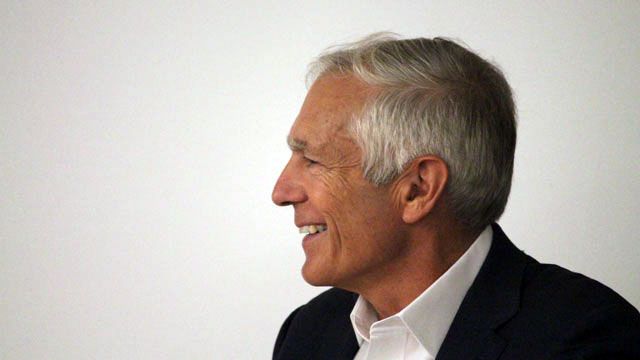“Why is it that every organization in the world can have a strategic plan except for the United States of America?” retired four-star Army General Wesley K. Clark asked rhetorically at a recent Burkle Center event.
Clark discussed his latest book, “Don't Wait for the Next War: A Strategy for American Growth and Global Leadership” (Public Affairs 2014) and outlined a formula for American success in the 21st century.
“There will always be crises,”Clark said, “but dealing with crises is not a strategy.” Instead, the United States needs to focus on external challenges, strengthen the economy and minimize domestic issues that divide the American people.
A graduate of West Point, Clark went on to a distinguished 34-year career in the United States Army and the Department of Defense. He saw combat in Vietnam as an infantry company commander and later served as Supreme Allied Commander Europe, leading NATO forces to victory in the Kosovo War. In 2004, he ran for the Democratic Party presidential nomination, but ultimately withdrew from the primary to campaign for John Kerry. Currently, Clark is chairman and CEO of Wesley K. Clark & Associates, a strategic consulting firm.
Eisenhower framework
The United States doesn’t have a strategy, said Clark, in contrast to China, a country that has consistently and explicitly maintained that its long-term strategic plan is to surpass the United States as the dominant global power.
“Around every Chinese dinner table, every one … understands that China will be the most powerful nation in the world soon,” explained Clark. “Some of them don't trust their own government, but they all see the vision.”
This sense of common purpose is fundamentally lacking in the United States, the speaker said, where Americans don’t understand the strategic U.S. role in the world. Instead, he maintained, the country has depended on wartime to unite it toward a common goal.
“This country can do great things if it ever pulls together,” said Clark, noting that the United States emerged from World War I as the wealthiest country in the world after having successfully mobilized 10 million men within an 18-month period.
After a relapse into isolationism in the 1920s, rearmament for World War II delivered the country out of severe economic recession. Clark argued that U.S. involvement in these two world wars gave the American people a sense of national purpose that had been previously lacking. However, the collapse of the Soviet Union in 1991 marked the disappearance of a distinct U.S. national strategy based on opposition to an adversary.
The decade that followed saw the ascent of China, the beginning of financial instability at home and the emergence of widespread international terrorism, culminating in the Sept. 11 attacks on the World Trade Center and the Pentagon.
The 2001 attacks defined a common anti-terrorism strategy for Americans, said Clark. However, he said, America needs to define its national purpose apart from countering serious threats.
Specifically, he recommended an approach adopted by President Dwight Eisenhower during the 1950s. “The strategy was about pulling Americans together,” said Clark, and confronting long-term threats without resorting to military action.
Eisenhower recognized that the real source of American power resided not in its military capacity, but in its economy and ability to produce and innovate. The president unwittingly constructed a military industrial complex by passing the National Defense Education Act of 1958, which created research and development tax credits and funded technology investments for the defense community.
Drawing inspiration from Eisenhower’s policies, Clark prescribed a new national strategy for America centered on economic development. He argued against cutting military spending and for funneling resources back into the armed forces, contending that the United States must maintain its technological edge through military spending, while also growing its economy.
Five major challenges
According to Clark, the United States faces five central challenges: terrorism, cyber stability, the stability of the financial system, the ascent of China and climate change.
“Each one … is big enough to really impact the country,” warned Clark. “Together, they're as severe as the existential threat of the Soviet Union and Marxism-Leninism more than a half century ago.” These challenges are long-term problems that are not easily solved without the involvement of the private sector, the U.S. government and the international community.
It is difficult to address these issues today because America has reached what Clark called an “inflection point” — a point of momentous change at which it is unclear whether American influence will decline or ascend. This moment of uncertainty, Clark claimed, is due in part to the 2008 financial crisis, inadequate economic growth and an appearance of “fumbling” in world affairs.
“We've got high debt, we've got fractious politics and we’ve got people around the world who don't quite believe in the American dream the way they did a decade and a half ago,” said Clark. “So, we've got to deal with America first — or simultaneously — as we address [these] challenges.”
The key: Oil production
Clarke's solution for rebuilding the U.S. economy? It’s oil. “This country is sitting on an energy bonanza,” he explained, “all it has to do is take it out of the ground.”
Instead, America spends $300 billion dollars each year to import foreign oil. This money could allow the country to address education, health care and unemployment. “Most importantly,” added Clark, “you'd stop this horrible divisive partisan politics because you'd [pay] down the national debt.”
Enacting a carbon tax on domestically produced oil would also allow the United States to emerge as an energy exporter and global environmental leader. “If we focus on natural resources, use what we have, put the government to work with the private sector in the most constructive way and systematically deal with these five long-term challenges,” Clark said, “we could … bring this country back together again.”
To read the full story, go to the International Institute website.




